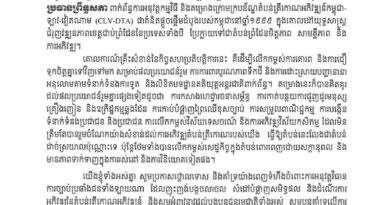ញត្តិគាំទ្ររបស់ថ្នាក់ដឹកនាំ មន្រ្តី បុគ្គលិក ភ្នាក់ងារ ពលករ និងឆ្មាំនៃអាជ្ញាធរជាតិអប្សរា ចំពោះសារពិសេសរបស់សម្ដេចអគ្គមហាសេនាបតីតេជោ ហ៊ុន សែន ប្រធានព្រឹទ្ធសភានៃព្រះរាជាណាចក្រកម្ពុជា លើការអនុវត្តកម្មវិធី និងគម្រោងក្រោមក្របខណ្ឌនៃតំបន់ត្រីកោណអភិវឌ្ឍ កម្ពុជា-ឡាវ-វៀតណាម (CLV-DTA)- 26 July 2024
ចំពោះសារពិសេសរបស់សម្ដេចអគ្គមហាសេនាបតីតេជោ ហ៊ុន សែន ប្រធានព្រឹទ្ធសភានៃព្រះរាជាណាចក្រកម្ពុជា លើការអនុវត្តកម្មវិធី និងគម្រោងក្រោមក្របខណ្ឌនៃតំបន់ត្រីកោណអភិវឌ្ឍ កម្ពុជា-ឡាវ-វៀតណាម (CLV-DTA)





